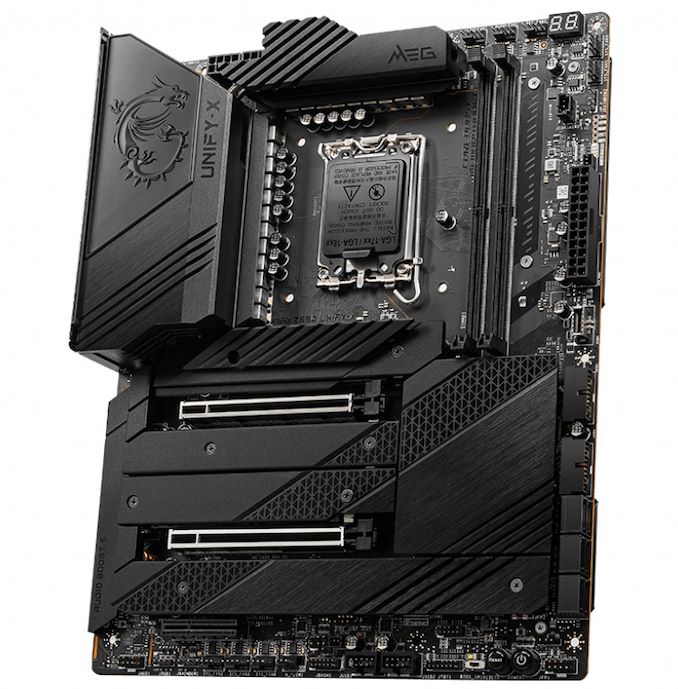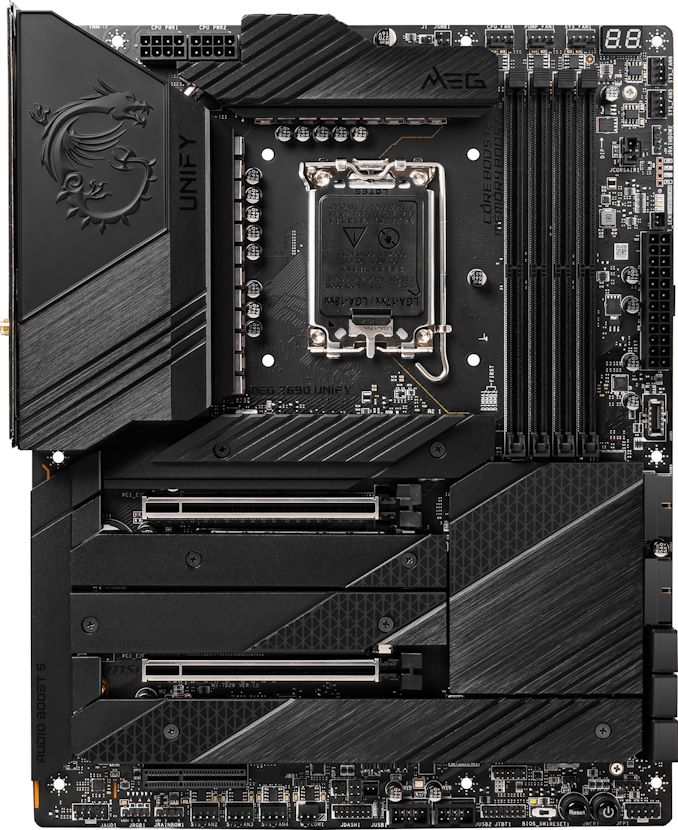The Intel Z690 Motherboard Overview (DDR5): Over 50+ New Models
by Gavin Bonshor on November 9, 2021 9:00 AM ESTMSI MEG Z690 Unify (DDR5) & Z690 Unify X (DDR5)
Sitting below the Godlike and Ace models in MSI's product stack is a pair of Unify branded models. Both the MSI MEG Z690 Unify and Z690 Unify X are a part of the MEG (MSI Enthusiast Gaming) series, with the same core feature set, but with two distinct differences. Aesthetically, both models share the exact same all-black aesthetic we've come to love from the Unify series. This approach was initially marketed as an alternative to RGB clad models, but it has become a solid series for enthusiasts with premium features, good power delivery specifications, and of course, pricing.

The MSI MEG Z690 Unify X with two DDR5-6800 capable memory slots
The MEG Z690 Unify features four memory slots with support for up to 128 GB of DDR5-6666 and is more suitable for gaming, while the MEG Z690 Unify X is aimed at extreme overclockers and enthusiasts with just two memory slots capable of supporting up to 64 GB of DDR5-6800.

The MSI MEG Z690 Unify with four memory slots capable of supporting DDR5-6666
Aside from the obvious differences in memory compatibility and support, both the MEG Z690 Unify and Unify X includes two full-length PCIe 5.0 slots operating at x16 and x8/x8, with a half-length PCIe 3.0 x4 slot. MSI is advertising a large 21-phase power delivery for both models, with both models sharing the same all-black and non-RGB enabled aesthetic, which is sure to please users looking for a more subtle look. Storage options are impressive across both models with four PCIe 4.0 x4 M.2 slots, one PCIe 3.0 x4 M.2 slot, and six SATA ports with support for RAID 0, 1, 5, and 10 arrays.
Both the MSI MEG Z690 Unify and Z690 Unify X are using the same controller set, and as a consequence, the rear panels are exactly the same. On the rear panel of both boards include one USB 3.2 G2x2 Type-C, seven USB 3.2 G2 Type-A, and two USB 2.0 ports. Networking support is strong, with two Intel I225-V 2.5 GbE controllers, and an Intel AX210 Wi-Fi 6E CNVi offering both wireless and BT 5.2 support. MSI hasn't specified the audio controllers, but there are five 3.5 mm audio jacks and a S/PDIF optical output powered by a Realtek ALC4080 HD audio codec. FInishing off the rear panel is a PS/2 combo port, a BIOS flashback button, and a clear CMOS button.











126 Comments
View All Comments
Duwelon - Tuesday, November 9, 2021 - link
Asus' prices are completely bananas. If I build a new rig with Z690 it'll probably be my first non-Asus build in a very long time.Sivar - Tuesday, November 9, 2021 - link
That caught my eye, too. I bought an Asus Hero-branded board for my current system last year at approximately $200 USD.I suspect Asus is shifting their marketspeak because the word "Maximus" (used for the z690 board but not mine) usually applies to their most expensive boards.
blppt - Tuesday, November 9, 2021 - link
This. $2000 for a consumer grade motherboard? WTF are they smoking?Also, I'm pretty sure ASUS will be releasing some TUF Z690s at some point, probably at a lower price point than the primes. My experience with the TUF series has been very positive for the price.
DigitalFreak - Tuesday, November 9, 2021 - link
They know they're not going to sell many of those. Those boards are either for LN2 e-peen competitions or people with more money than sense.Wrs - Wednesday, November 10, 2021 - link
TUF is historically just a bit more expensive than Prime. They already have a TUF DDR4 version - ordered the Wifi one for $290 the other day. If worried about price DDR5 is the first mistake.blppt - Wednesday, November 10, 2021 - link
The X570 TUF was cheaper than the X570 Prime when I went shopping for an AMD board.COtech - Tuesday, November 9, 2021 - link
Subtitle - "Intel Z690 Chipset: Like Z590, But Now With Native PCIe 4.0"I think "But Now With Native PCIe 5.0" is intended.
gavbon - Thursday, November 18, 2021 - link
The Z690 chipset doesn't have PCIe 5.0, this comes from the CPU. The Z690 chipset does, however, now include PCIe 4.0 lanes, whereas Z590 did not.Someguyperson - Tuesday, November 9, 2021 - link
I don't get the "DP IN" ports on the ASUS ProArt Z690 Creator WIFI. I see the author just wrote what was on the ASUS website, but that doesn't really explain anything. Are they passthrough to the Thunderbolt out ports? Is there a capture card built into this motherboard? I'm very confused by the labeling here.uwsalt - Tuesday, November 9, 2021 - link
Those are passthrough to the Thunderbolt port. Add-in Thunderbolt cards work the same way. You slot in your discrete GPU, send the output from both DP ports to the Thunderbolt controller, and then use Thunderbolt to output to a Thunderbolt monitor or hub.